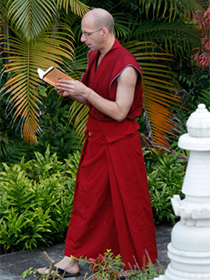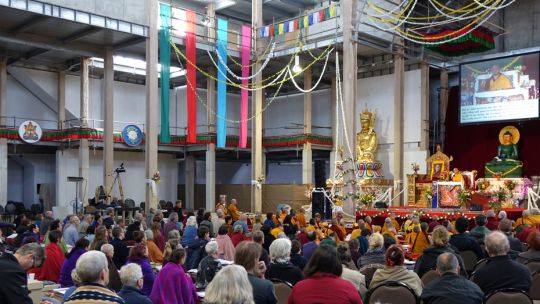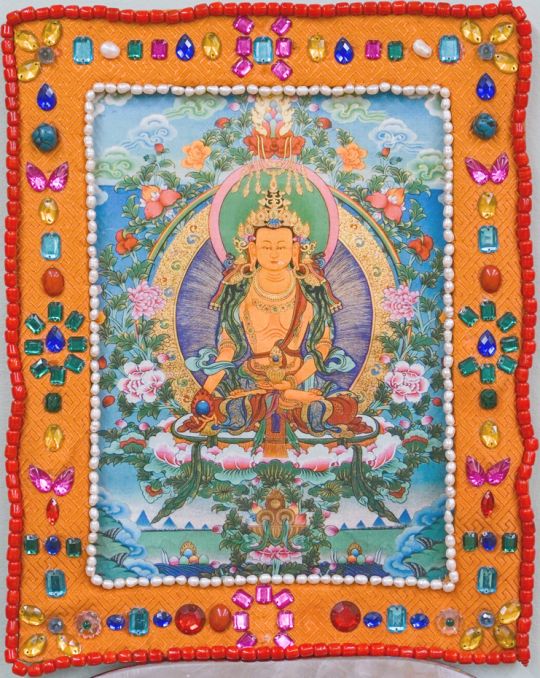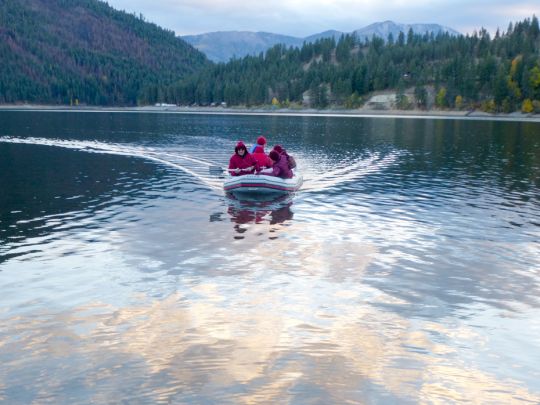- Home
- FPMT Homepage
Foundation for the Preservation of the Mahayana Tradition
The FPMT is an organization devoted to preserving and spreading Mahayana Buddhism worldwide by creating opportunities to listen, reflect, meditate, practice and actualize the unmistaken teachings of the Buddha and based on that experience spreading the Dharma to sentient beings. We provide integrated education through which people’s minds and hearts can be transformed into their highest potential for the benefit of others, inspired by an attitude of universal responsibility and service. We are committed to creating harmonious environments and helping all beings develop their full potential of infinite wisdom and compassion. Our organization is based on the Buddhist tradition of Lama Tsongkhapa of Tibet as taught to us by our founders Lama Thubten Yeshe and Lama Thubten Zopa Rinpoche.
- Willkommen
Die Stiftung zur Erhaltung der Mahayana Tradition (FPMT) ist eine Organisation, die sich weltweit für die Erhaltung und Verbreitung des Mahayana-Buddhismus einsetzt, indem sie Möglichkeiten schafft, den makellosen Lehren des Buddha zuzuhören, über sie zur reflektieren und zu meditieren und auf der Grundlage dieser Erfahrung das Dharma unter den Lebewesen zu verbreiten.
Wir bieten integrierte Schulungswege an, durch denen der Geist und das Herz der Menschen in ihr höchstes Potential verwandelt werden zum Wohl der anderen – inspiriert durch eine Haltung der universellen Verantwortung und dem Wunsch zu dienen. Wir haben uns verpflichtet, harmonische Umgebungen zu schaffen und allen Wesen zu helfen, ihr volles Potenzial unendlicher Weisheit und grenzenlosen Mitgefühls zu verwirklichen.
Unsere Organisation basiert auf der buddhistischen Tradition von Lama Tsongkhapa von Tibet, so wie sie uns von unseren Gründern Lama Thubten Yeshe und Lama Thubten Zopa Rinpoche gelehrt wird.
- Bienvenidos
La Fundación para la preservación de la tradición Mahayana (FPMT) es una organización que se dedica a preservar y difundir el budismo Mahayana en todo el mundo, creando oportunidades para escuchar, reflexionar, meditar, practicar y actualizar las enseñanzas inconfundibles de Buda y en base a esa experiencia difundir el Dharma a los seres.
Proporcionamos una educación integrada a través de la cual las mentes y los corazones de las personas se pueden transformar en su mayor potencial para el beneficio de los demás, inspirados por una actitud de responsabilidad y servicio universales. Estamos comprometidos a crear ambientes armoniosos y ayudar a todos los seres a desarrollar todo su potencial de infinita sabiduría y compasión.
Nuestra organización se basa en la tradición budista de Lama Tsongkhapa del Tíbet como nos lo enseñaron nuestros fundadores Lama Thubten Yeshe y Lama Zopa Rinpoche.
A continuación puede ver una lista de los centros y sus páginas web en su lengua preferida.
- Bienvenue
L’organisation de la FPMT a pour vocation la préservation et la diffusion du bouddhisme du mahayana dans le monde entier. Elle offre l’opportunité d’écouter, de réfléchir, de méditer, de pratiquer et de réaliser les enseignements excellents du Bouddha, pour ensuite transmettre le Dharma à tous les êtres. Nous proposons une formation intégrée grâce à laquelle le cœur et l’esprit de chacun peuvent accomplir leur potentiel le plus élevé pour le bien d’autrui, inspirés par le sens du service et une responsabilité universelle. Nous nous engageons à créer un environnement harmonieux et à aider tous les êtres à épanouir leur potentiel illimité de compassion et de sagesse. Notre organisation s’appuie sur la tradition guéloukpa de Lama Tsongkhapa du Tibet, telle qu’elle a été enseignée par nos fondateurs Lama Thoubtèn Yéshé et Lama Zopa Rinpoché.
Visitez le site de notre Editions Mahayana pour les traductions, conseils et nouvelles du Bureau international en français.
Voici une liste de centres et de leurs sites dans votre langue préférée
- Benvenuto
L’FPMT è un organizzazione il cui scopo è preservare e diffondere il Buddhismo Mahayana nel mondo, creando occasioni di ascolto, riflessione, meditazione e pratica dei perfetti insegnamenti del Buddha, al fine di attualizzare e diffondere il Dharma fra tutti gli esseri senzienti.
Offriamo un’educazione integrata, che può trasformare la mente e i cuori delle persone nel loro massimo potenziale, per il beneficio di tutti gli esseri, ispirati da un’attitudine di responsabilità universale e di servizio.
Il nostro obiettivo è quello di creare contesti armoniosi e aiutare tutti gli esseri a sviluppare in modo completo le proprie potenzialità di infinita saggezza e compassione.
La nostra organizzazione si basa sulla tradizione buddhista di Lama Tsongkhapa del Tibet, così come ci è stata insegnata dai nostri fondatori Lama Thubten Yeshe e Lama Zopa Rinpoche.
Di seguito potete trovare un elenco dei centri e dei loro siti nella lingua da voi prescelta.
- 欢迎 / 歡迎
简体中文
“护持大乘法脉基金会”( 英文简称:FPMT。全名:Foundation for the Preservation of the Mahayana Tradition) 是一个致力于护持和弘扬大乘佛法的国际佛教组织。我们提供听闻,思维,禅修,修行和实证佛陀无误教法的机会,以便让一切众生都能够享受佛法的指引和滋润。
我们全力创造和谐融洽的环境, 为人们提供解行并重的完整佛法教育,以便启发内在的环宇悲心及责任心,并开发内心所蕴藏的巨大潜能 — 无限的智慧与悲心 — 以便利益和服务一切有情。
FPMT的创办人是图腾耶喜喇嘛和喇嘛梭巴仁波切。我们所修习的是由两位上师所教导的,西藏喀巴大师的佛法传承。
繁體中文
護持大乘法脈基金會”( 英文簡稱:FPMT。全名:Found
ation for the Preservation of the Mahayana Tradition ) 是一個致力於護持和弘揚大乘佛法的國際佛教組織。我們提供聽聞, 思維,禪修,修行和實證佛陀無誤教法的機會,以便讓一切眾生都能 夠享受佛法的指引和滋潤。 我們全力創造和諧融洽的環境,
為人們提供解行並重的完整佛法教育,以便啟發內在的環宇悲心及責 任心,並開發內心所蘊藏的巨大潛能 — 無限的智慧與悲心 – – 以便利益和服務一切有情。 FPMT的創辦人是圖騰耶喜喇嘛和喇嘛梭巴仁波切。
我們所修習的是由兩位上師所教導的,西藏喀巴大師的佛法傳承。 察看道场信息:
- FPMT Homepage
- News/Media
-
- Study & Practice
-
-
- About FPMT Education Services
- Latest News
- Programs
- New to Buddhism?
- Buddhist Mind Science: Activating Your Potential
- Heart Advice for Death and Dying
- Discovering Buddhism
- Living in the Path
- Exploring Buddhism
- FPMT Basic Program
- FPMT Masters Program
- FPMT In-Depth Meditation Training
- Maitripa College
- Lotsawa Rinchen Zangpo Translator Program
- Universal Education for Compassion & Wisdom
- Online Learning Center
-
- Prayers & Practice Materials
- Overview of Prayers & Practices
- Full Catalogue of Prayers & Practice Materials
- Explore Popular Topics
- Benefiting Animals
- Chenrezig Resources
- Death & Dying Resources
- Lama Chopa (Guru Puja)
- Lama Zopa Rinpoche: Compendium of Precious Instructions
- Lama Zopa Rinpoche: Life Practice Advice
- Lama Zopa Rinpoche Practice Series
- Lamrim Resources
- Mantras
- Prayer Book Updates
- Purification Practices
- Sutras
- Thought Transformation (Lojong)
- Audio Materials
- Dharma Dates - Tibetan Calendar
- Translation Services
- Publishing Services
- Ways to Offer Support
- Prayers & Practice Materials
-
- Teachings and Advice
- Find Teachings and Advice
- Lama Zopa Rinpoche Advice Page
- Lama Zopa Rinpoche: Compendium of Precious Instructions
- Lama Zopa Rinpoche Video Teachings
- ༧སྐྱབས་རྗེ་བཟོད་པ་རིན་པོ་ཆེ་མཆོག་ནས་སྩལ་བའི་བཀའ་སློབ་བརྙན་འཕྲིན།
- Podcasts
- Lama Yeshe Wisdom Archive
- Buddhism FAQ
- Dharma for Young People
- Resources on Holy Objects
- Teachings and Advice
-
-
*If a menu item has a submenu clicking once will expand the menu clicking twice will open the page.
-
-
- Centers
-
- Teachers
-
- Projects
-
-
-
-
*If a menu item has a submenu clicking once will expand the menu clicking twice will open the page.
-
-
- FPMT
-
-
-
-
-
It is necessary to help others, not only in our prayers, but in our daily lives. If we find we cannot help others, the least we can do is to not harm them.
His Holiness the Dalai Lama
-
-
-
- Shop
-
-
-
The Foundation Store is FPMT’s online shop and features a vast selection of Buddhist study and practice materials written or recommended by our lineage gurus. These items include homestudy programs, prayers and practices in PDF or eBook format, materials for children, and other resources to support practitioners.
Items displayed in the shop are made available for Dharma practice and educational purposes, and never for the purpose of profiting from their sale. Please read FPMT Foundation Store Policy Regarding Dharma Items for more information.
-
-
Lama Zopa Rinpoche News
13

Sangha from Australia and New Zealand leading Lama Zopa Rinpoche to the teaching hall at the Light of the Path retreat, North Carolina, US, September 2017. Photo by Ven. Lobsang Sherab.
In the video below, Lama Zopa Rinpoche talks about the impact of keeping vows on the power of prayer. He says that the more vows we have, and keep purely, the more power our prayers will have. Therefore, when monastics pray for others, their prayers “have so much power”!
Whatever monks and nuns pray for will have more success because of their vows, says Rinpoche in the video, which was recorded at the Light of the Path 2016 retreat. Making offerings to monks and nuns is also very meritorious because their many vows help make them more pure; such offerings have enormous future karmic benefits for whoever makes them.
Watch Rinpoche talk on YouTube about the relationship between vows, merit, and effective prayers:
https://www.youtube.com/watch?v=XULE495JKZ0&feature=youtu.be
Watch more video from the 2016 Light of the Path Retreat and find links to translations, MP3s, and the complete transcript:
https://fpmt.org/media/streaming/teachings-of-lama-zopa-rinpoche/light-of-the-path-teachings-2016/
Watch Lama Zopa Rinpoche teach LIVE at the Light of the Path retreat August 20-September 17, 2017:
https://fpmt.org/media/streaming/lama-zopa-rinpoche-live/
It’s not too late to join Lama Zopa Rinpoche’s 100 Million Mani Retreat at Istituto Lama Tzong Khapa in Italy: October 4-November 5, 2017. Find out more at:
https://www.iltk.org/en/lama-zopa-rinpoche-2017/
Lama Zopa Rinpoche is the spiritual director of the Foundation for the Preservation of Mahayana Tradition (FPMT), a Tibetan Buddhist organization dedicated to the transmission of the Mahayana Buddhist tradition and values worldwide through teaching, meditation, and community service.
- Tagged: essential extract, lama zopa rinpoche, light of the path, light of the path 2016, monks, nuns, prayer, video
11
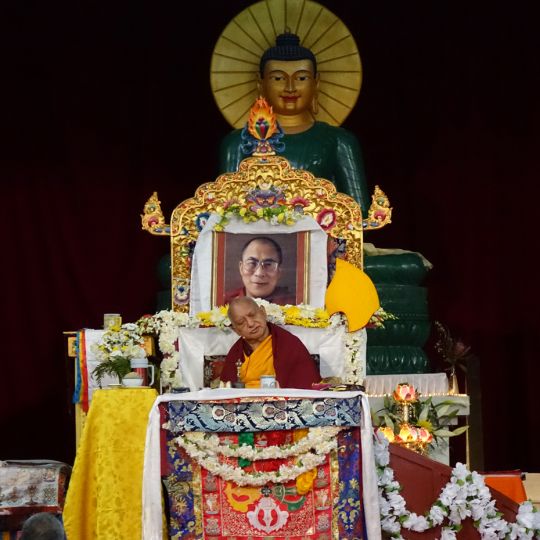
Lama Zopa Rinpoche teaching at Australia 2014 retreat at the Great Stupa of Universal Compassion, Bendigo, Australia, October 2014. Photo by Ven. Roger Kunsang.
Registration is now open for Lama Zopa Rinpoche’s Bodhicaryavatara and Rinjung Gyatsa retreat at the Great Stupa of Universal Compassion in Bendigo, Australia, March 30-May 12, 2018! This six-week retreat is the third in series of retreats given in Australia by Rinpoche.
“This retreat came about because the late Khunu Lama Rinpoche requested Lama Zopa Rinpoche to translate Shantideva’s Bodhicaryavatara (A Guide to the Bodhisattva’s Way of Life),” explained Ven. Roger Kunsang, Rinpoche’s assistant and CEO of FPMT. “Khunu Lama Rinpoche made this request after he gave Lama Zopa Rinpoche the commentary on the Bodhicaryavatara at Lama Zopa Rinpoche’s request. So Lama Zopa Rinpoche is teaching the Bodhicaryavatara at the same time as translating it. (A small team led by Ven. Ailsa Cameron is carefully noting Rinpoche’s translation as he teaches.)
“Then Lama Zopa Rinpoche was requested by Ven. Gyatso (director of Thubten Shedrup Ling Monastery in Bendigo) to give the Rinjung Gyatsa set of initiations, which is quite rare. Rinpoche commented that it is common in the Tibetan Buddhist tradition to organize initiations into ‘sets.’ Also that different deities have different purposes and benefits, and that once you receive the permission to practice that deity, you have more potential to help others and are also helping to preserve Buddhism.
“Lama Zopa Rinpoche has combined both into one retreat. The first installment of this retreat was in April 2011 and the second installment took place in September-October 2014.”
You can register for the Bodhicaryavatara and Rinjung Gyatsa retreat 2018 at the Great Stupa and find additional information on the retreat website:
http://lamazoparetreat2018.org.au/
An early-bird discount is offered on registration before October 31, 2017.
Read about the April 2011 retreat in the Mandala story “The Retreat of a Life Time.” The September-October 2014 retreat was covered in many FPMT news blog posts, which include links to video from Rinpoche’s teachings there. You can also access video recordings of Rinpoche’s teachings from the Australia 2014 retreat on FPMT’s Rinpoche Available Now page (fpmt.org/rinpochenow/).
Watch Lama Zopa Rinpoche teach LIVE at the Light of the Path retreat August 20-September 17, 2017:
https://fpmt.org/media/streaming/lama-zopa-rinpoche-live/
It’s not too late to join Lama Zopa Rinpoche’s 100 Million Mani Retreat at Istituto Lama Tzong Khapa in Italy: October 4-November 5, 2017. Find out more at:
https://www.iltk.org/en/lama-zopa-rinpoche-2017/
Lama Zopa Rinpoche is the spiritual director of the Foundation for the Preservation of Mahayana Tradition (FPMT), a Tibetan Buddhist organization dedicated to the transmission of the Mahayana Buddhist tradition and values worldwide through teaching, meditation, and community service.
- Tagged: australia retreat 2018, lama zopa rinpoche
7
The retreatants at the Light of the Path 2017 retreat spent a practice session reciting Kshitigarbha mantras on Tuesday, September 5. Participants did 2,000 recitations of the long Kshitigarbha mantra and 10,000 recitations of the middle-length Kshitigarbha mantra at Lama Zopa Rinpoche’s request. On Wednesday, September 6, they did 13,000 recitations of the middle-length mantra. The practice was dedicated to pacify the harm caused by natural disasters, especially from upcoming hurricanes.
Students concerned about Hurricane Irma, which as of Thursday afternoon is a category 5 hurricane tearing through the Caribbean towards Florida, can recite the middle-length Kshitigarbha mantra:
OM SUMBHA NI SUMBHA / HARA TSARA / MAHAA PAASHA MARAUTAA / AMOGHA VAJRASATTVA SWAAHAA
In the past, Rinpoche has also advised to do Kshitigarbha practice and protector prayers to pacify harm from hurricanes. You can find more advice from Rinpoche on natural disasters on FPMT’s Advice from Lama Zopa Rinpoche page.
Watch Light of the Path Recite Kshitigarbha Mantra:
https://youtu.be/WM3TQtoE850?t=1922
Links to resources mentioned in the post:
Middle-length Kshitigarbha mantra:
https://shop.fpmt.org/Ksitigarbha-Mantras-PDF_p_3611.html
Kshitigarbha Practice complied by Lama Zopa Rinpoche:
https://shop.fpmt.org/Kshitigarbha-Practice-eBook-PDF_p_2522.html
Protector prayers:
https://shop.fpmt.org/Protector-Prayers-PDF_p_1381.html
Advice from Lama Zopa Rinpoche on FPMT.org:
https://fpmt.org/teachers/zopa/advice/
Watch Lama Zopa Rinpoche teach LIVE at the Light of the Path 2017 retreat August 20-September 17:
https://fpmt.org/media/streaming/lama-zopa-rinpoche-live/
Lama Zopa Rinpoche is the spiritual director of the Foundation for the Preservation of Mahayana Tradition (FPMT), a Tibetan Buddhist organization dedicated to the transmission of the Mahayana Buddhist tradition and values worldwide through teaching, meditation, and community service.
6
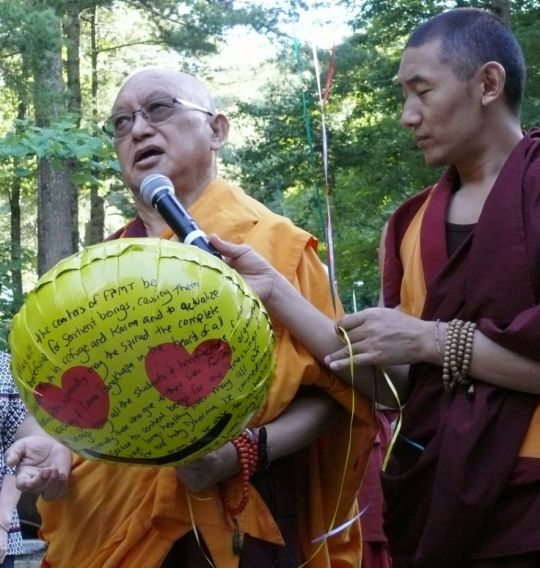
Lama Zopa Rinpoche before mantra balloon release at Light of the Path retreat, Black Mountain, North Carolina, US, August 2017. Photos by Kalleen Mortensen.
Lama Zopa Rinpoche released balloons with mantras he had written on them to bless all the sentient beings who pass underneath them. During a break between sessions at the Light of the Path in North Carolina, Rinpoche had the retreatants gather and explained the meanings of some of the mantras written on the balloons before they were released.
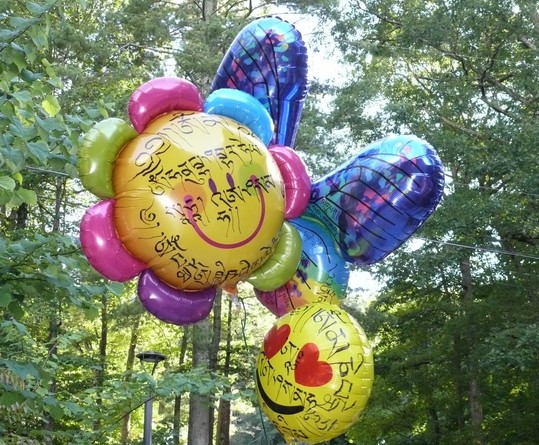
Mantra balloons before being released to spread blessing to all sentient beings who pass underneath them
The mantras included OM MANI PADME HUM (the mantra of the Buddha of Compassion), the “Just by Seeing” mantra, “Six Syllables of Clairvoyance” mantra, and the “Lotus Pinnacle” mantra. The balloons also had extensive dedications written on them, which were read aloud. Rinpoche’s explanation, the dedications, and the balloon release were captured in a five-minute video.
WATCH Rinpoche Explain the Benefits of Mantra Balloons on YouTube:
https://youtu.be/aL_UfDb3B6Y
Find more resources on mantras on FPMT Education Services’ mantra page:
https://fpmt.org/education/prayers-and-practice-materials/mantras/
Watch Lama Zopa Rinpoche teach LIVE at the Light of the Path 2017 retreat August 20-September 17:
https://fpmt.org/media/streaming/lama-zopa-rinpoche-live/
Lama Zopa Rinpoche is the spiritual director of the Foundation for the Preservation of Mahayana Tradition (FPMT), a Tibetan Buddhist organization dedicated to the transmission of the Mahayana Buddhist tradition and values worldwide through teaching, meditation, and community service.
- Tagged: balloon release, just by seeing mantra, lama zopa rinpoche video short, light of the path, light of the path 2017, lotus pinnacle mantra, mantras, six syllables of clairvoyance mantra, video
4
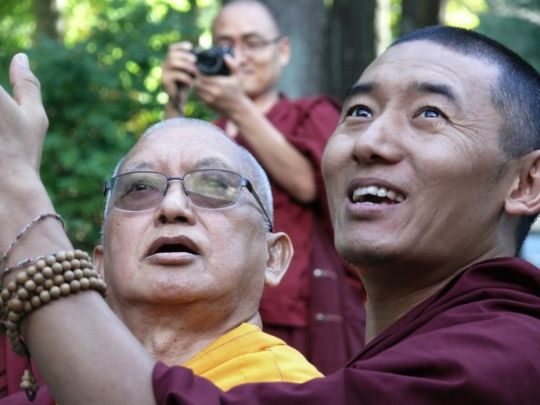
Lama Zopa Rinpoche and Ven. Sangpo Sherpa watch balloons with mantras written on them float up into the sky and spread blessings, Black Mountain, North Carolina, US, August 2017. Photo by Kalleen Mortensen.
“How does taking vows or Mahayana precepts helps end famine and war?” a student asked Lama Zopa Rinpoche during the Light of the Path 2016 retreat. Rinpoche’s reply was captured in the video below.
Rinpoche responds by saying, “those vows have power!” He then talks about the positive impact of taking vows and precepts.Vows, he says, have power because the mind has power, and vows help make the mind positive.
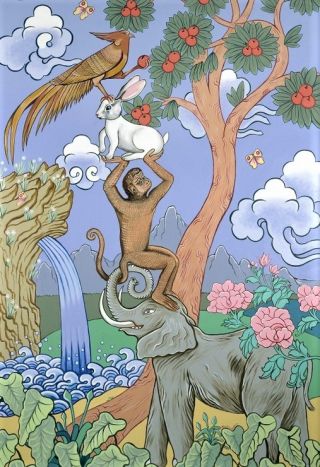
The four harmonious friends. Photo FPMT.
Rinpoche briefly tells the story of the four harmonious friends, who all live in the five precepts. Due to the power of these vows, everything in their area is “auspicious”: rains come and crops flourish. The natural world, the environment, and the economy thrive. This, Rinpoche explains, is due to the power of positive mental states.
Because our experiences arise from the power of mind, the positivity created by vows has an effect, including stopping wars and so on. Thus, Rinpoche declares, “living in vows affects the world through the power of mind.”
Watch Rinpoche talk on YouTube about the power of vows and precepts:
https://youtu.be/kyYq8y3PqWo
Watch more video from the 2016 Light of the Path Retreat and find links to translations, MP3s, and the complete transcript:
https://fpmt.org/media/streaming/teachings-of-lama-zopa-rinpoche/light-of-the-path-teachings-2016/
Watch Lama Zopa Rinpoche teach LIVE at the Light of the Path 2017 retreat August 20-September 17:
https://fpmt.org/media/streaming/lama-zopa-rinpoche-live/
Lama Zopa Rinpoche is the spiritual director of the Foundation for the Preservation of Mahayana Tradition (FPMT), a Tibetan Buddhist organization dedicated to the transmission of the Mahayana Buddhist tradition and values worldwide through teaching, meditation, and community service.
- Tagged: eight mahayana precepts, essential extract, four harmonious friends, lama zopa rinpoche, light of the path 2016, mind, video
30
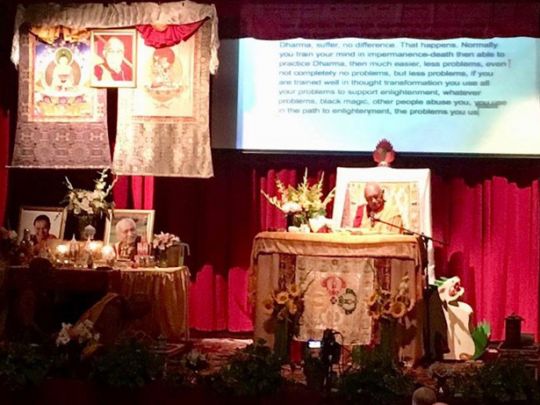
Lama Zopa Rinpoche teaching at Thubten Norbu Ling, Santa Fe, New Mexico, US, August 2017. Photo courtesy of Thubten Norbu Ling.
From August 9-14, Thubten Norbu Ling in Santa Fe, New Mexico, USA, hosted Lama Zopa Rinpoche for a series of teachings, jenangs, and an initiation. Spiritual program coordinator Bonnie Povolny shared news about the visit:
The initial session on August 9 began with a two-hour teaching prior to a White Manjushri jenang. His comments peppered with laughter, Lama Zopa greeted the audience saying, “Thank you very much! … For some, the first time to meet, and some, we met in the past. Some long time ago and some recent. Lama Yeshe says, ‘When you meet friends, a benefit to not being dead is to meet again.’ So like here, we meet again. ‘Again’ is two things: first one is that we met in a past life, so ‘again.’ The second one, [we’ve met] many times in this life, ‘again.’ ‘Again’ has two different meanings.” He continued by reminding us that we may have met in many different sentient forms: animals, insects, humans, ants, pigs, mothers, fathers, sisters, brothers, friends, and enemies.
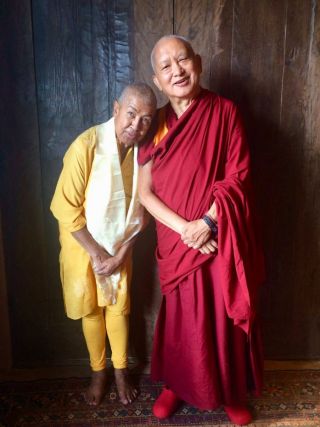
Lama Zopa Rinpoche and Ven. Max Mathews, Thubten Norbu Ling, Santa Fe, New Mexico, US, August 2017. Photo courtesy of Thubten Norbu Ling.
Prior to the Vajrasattva jenang on August 10, Lama Zopa fielded a question about the title of his book, How to Enjoy Death, emphasizing in a joyful way that death is something we all will experience, should not fear, and that we have absolutely no idea when it will occur.
On August 11, the day when Lama Zopa was not teaching, the group met for a recitation of the Vajra Cutter Sutra, dedicated to Lama Zopa Rinpoche’s long life.
The schedule was rearranged to accommodate an extended teaching on August 12 in which Lama Zopa Rinpoche helped us to develop a more clear view of reality. There was an emphasis on the problems caused by the belief in the inherent “I” and how even one person can cause long-term, worldwide problems. Both the preparation for and the initiation into the Great Medicine Buddha were conducted the following day.
The teachings were dedicated to Lama Zopa’s long life, His Holiness the Dalai Lama’s long life, and to a successful capital campaign for a new center for Thubten Norbu Ling.
Lama Zopa Rinpoche met for lunch with the board of Thubten Norbu Ling on August 14 to further discuss the capital campaign for a new center. Afterward, he returned to bless the center and give a transmission, the lung of Chanting the Names of Manjushri. Later in the afternoon, he met with and blessed the volunteers.
All of us at Thubten Norbu Ling feel incredibly grateful for the opportunity to be in the presence of and receive teachings from Lama Zopa. His teachings and presence in Santa Fe opened the hearts and minds of so many people. May his health be strong and his life be long for the benefit of all sentient beings!

Lama Zopa Rinpoche with Geshe Sherab, and Don Handrick, who are the resident geshe and resident teacher, respectively, at Thubten Norbu Ling, Santa Fe, New Mexico, US, August 2017. Photo courtesy of Thubten Norbu Ling.
Watch Lama Zopa Rinpoche teach LIVE at the Light of the Path 2017 retreat August 20-September 17:
https://fpmt.org/media/streaming/lama-zopa-rinpoche-live/
Watch video recordings of Lama Zopa Rinpoche teaching at Thubten Norbu Ling:
https://fpmt.org/media/streaming/teachings-of-lama-zopa-rinpoche/lama-zopa-rinpoche-teachings-in-Santa-Fe-USA-2017/
Read more about the teachings, educational programs, and events at Thubten Norbu Ling:
http://www.tnlsf.org
FPMT.org and Mandala Publications brings you news of Lama Zopa Rinpoche and of activities, teachings and events from over 160 FPMT centers, projects and services around the globe. If you like what you read, consider becoming a Friend of FPMT, which supports our work.
- Tagged: thubten norbu ling, ven max mathews
23
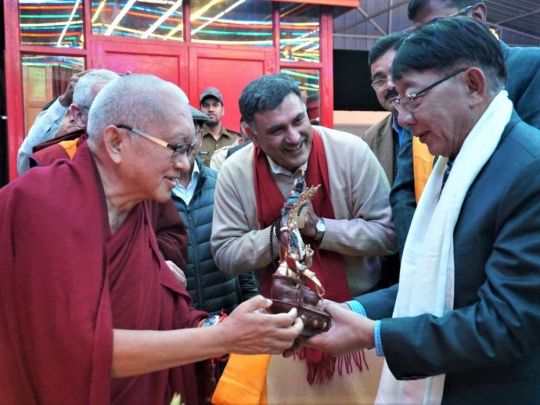
Rinpoche meeting local dignitaries at Root Institute. Bodhgaya, India, January 2017. Photo by Ven. Lobsang Sherab.
While he was in Bodhgaya, India, in January this year, Lama Zopa Rinpoche invited some influential people onto the roof of the FPMT center, Root Institute, for a small party. Included were actor Richard Gere as well as a number of local politicians and dignitaries.
During the event, Rinpoche spoke briefly about why he wants to build statues of Maitreya Buddha. The statues, he said, help people develop a good heart. That good heart in turn will help create peace and happiness in the world.
Listen to Rinpoche discuss the role of Maitreya Buddha statues in creating a peaceful and happy world on YouTube:
https://youtu.be/AYVk1VrRsek
Watch Lama Zopa Rinpoche teach LIVE at the Light of the Path 2017 retreat, August 20-September 17:
https://fpmt.org/media/streaming/lama-zopa-rinpoche-live/
Lama Zopa Rinpoche is the spiritual director of the Foundation for the Preservation of Mahayana Tradition (FPMT), a Tibetan Buddhist organization dedicated to the transmission of the Mahayana Buddhist tradition and values worldwide through teaching, meditation and community service.
- Tagged: buddha maitreya bodhgaya, lama zopa rinpoche, lama zopa rinpoche video short, richard gere, root institute, video
21
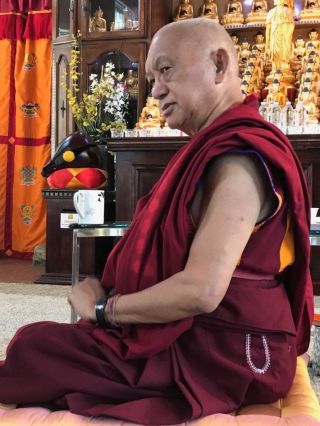
Lama Zopa Rinpoche, Kadampa Center, Raleigh, North Carolina, US, August 2017. Photo via Twitter, (@LamaZopa).
Lama Zopa Rinpoche arrived in Raleigh, North Carolina, United States, where he taught on August 19 at Kadampa Center. Then he traveled to Black Mountain where the month-long Light of the Path 2017 retreat commenced on the evening of August 20. This retreat is the fifth in a series of teaching retreats led by Rinpoche based on Lama Atisha’s text Lamp for the Path to Enlightenment.
FPMT is live video streaming Rinpoche’s teachings at the retreat in several languages. Find links to all the live video streams here:
https://fpmt.org/media/streaming/lama-zopa-rinpoche-live/
The first full day of teachings, Monday, August 21, coincides with the total solar eclipse that is crossing the United States. The retreat venue lies just outside the path of totality. Rinpoche has given advice on practices to do on eclipse days as they are merit multiplying days and can be done wherever you are in the world.
The Light of the Path retreat ends on September 17. Similar to past years, recordings and unedited transcripts from the retreat as well as Rinpoche’s teachings from other events are available on FPMT’s Rinpoche Available Now page.
Students are also encouraged to explore the Living in the Path education program, created by FPMT Education Services. Based on Rinpoche’s teachings at the Light of the Path retreats, Living in the Path is an ever-growing collection of Rinpoche’s heart advice and lamrim teachings.
Rinpoche Available Now:
https://fpmt.org/RinpocheNow
Living in the Path:
https://fpmt.org/education/programs/living-in-the-path/
Eclipse day practices:
https://fpmt.org/edu-news/practices-during-the-upcoming-solar-eclipse/
Lama Zopa Rinpoche is the spiritual director of the Foundation for the Preservation of Mahayana Tradition (FPMT), a Tibetan Buddhist organization dedicated to the transmission of the Mahayana Buddhist tradition and values worldwide through teaching, meditation and community service.
- Tagged: lama zopa rinpoche, light of the path 2017
16
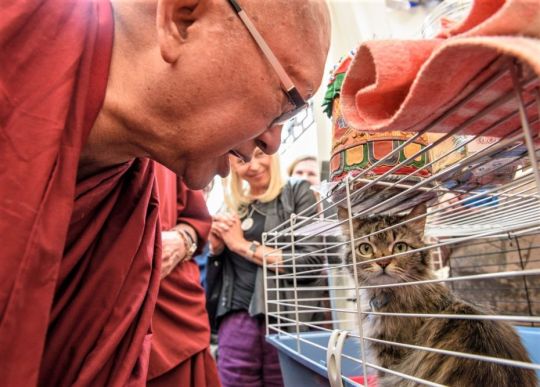
Lama Zopa Rinpoche blesses a cat in Russia. May 2017. Photo by Renat Alyaudinov.
Wherever he goes, Lama Zopa Rinpoche tries to find time to offer blessings not just to humans but also to animals. For example, in July, in New Mexico, Rinpoche blessed wild horses. In June, in California, Rinpoche blessed the Pacific Ocean and all the beings it in. In Russia, in May, Rinpoche made time to bless hundreds of pets of all kinds, including cats that had been brought from a shelter. In Nepal in April 2017, he blessed goats. And the list goes on.
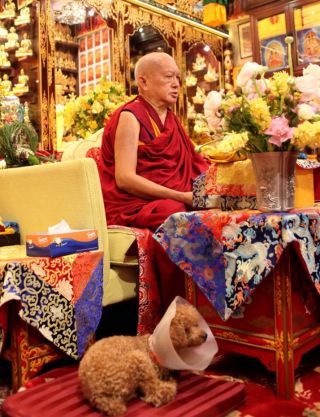
Lama Zopa Rinpoche teaches in Cham Tse Ling gompa with small dog in attendance. Hong Kong, April 2016. Photo by Ven. Thubten Kunsang.
When he stays at Buddha Amitabha Pure Land (BAPL) in Washington State, United States, Lama Zopa Rinpoche takes many measures to benefit the living beings—animals, insects, snakes, birds, and fish—who share the land and water there. Resident Sangha and visitors do the same on a regular basis even when Rinpoche is not present. Methods include the recitation of mantras, sutras, and prayers, as well as offering blessed food and other activities.
Many of these ways to bless small creatures are described by Ven. Tharchin, a resident of BAPL, in a 25-minute YouTube video on FPMT’s YouTube channel (see below).
According to Rinpoche in his book Liberating Animals from the Danger of Death, sentient beings can experience purification of their karma and avoid the lower realms in the future as a result of such practices. Rinpoche says: “When the Buddha gave teachings to 500 swans in a field, in their next life they were born as human beings. They became monks and all became arya beings, able to achieve the cessation of suffering and the true path. So the result is unbelievable, just by hearing Dharma words.”
Watch Ven. Tharchin, a resident of Buddha Amitabha Pure Land, explain the many measures that are taken there to benefit living beings:
https://youtu.be/aqORZkZoAqQ
Benefiting animals is one of Lama Zopa Rinpoche’s Vast Visions for FPMT:
https://fpmt.org/fpmt/vast-vision/#animals
For more about FPMT’s activities to benefit animals see:
https://fpmt.org/tag/animals/
Get Liberating Animals from the Danger of Death as an e-book or in a print copy from the Foundation Store and support FPMT International Office:
https://shop.fpmt.org/Liberating-Animals-eBook_p_2334.html
Watch Lama Zopa Rinpoche teach LIVE at the Light of the Path 2017 retreat August 20-September 17:
https://fpmt.org/media/streaming/lama-zopa-rinpoche-live/
Lama Zopa Rinpoche is the spiritual director of the Foundation for the Preservation of Mahayana Tradition (FPMT), a Tibetan Buddhist organization dedicated to the transmission of the Mahayana Buddhist tradition and values worldwide through teaching, meditation and community service.
- Tagged: animals, buddha amitabha pure land, lama zopa rinpoche, russia, video, video short
7
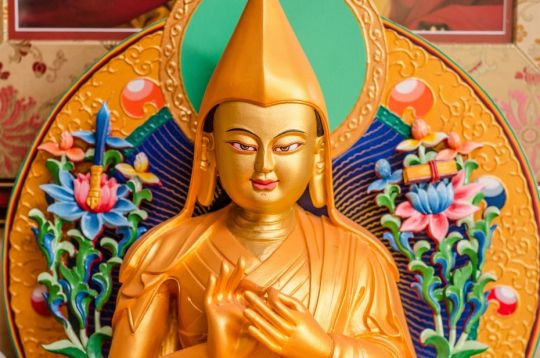
Statue of Lama Tsongkhapa at Kachoe Dechen Ling, Lama Zopa Rinpoche’s home in California, US, 2015. Photo by Chris Majors.
When training in the graduated path to enlightenment (lamrim), Lama Zopa Rinpoche emphasizes that bodhichitta is most important.
In the video clip below, recorded during the Light of the Path 2016 retreat, Rinpoche notes that although bodhichitta as a topic appears quite late in the lamrim, in fact students should have a bodhichitta motivation for all their activities from the beginning. Even learning or meditating on the initial stages of the path, like guru devotion, should be done with a bodhichitta motivation, and so should all of every Dharma student’s daily activities. “You have to know that,” says Rinpoche.
That bodhichitta motivation is how students move toward enlightenment, Rinpoche explains, and how everything they do becomes a cause for freeing sentient beings from samsara. Rinpoche stresses that those teaching and studying lamrim need to make bodhichitta the emphasis at all times.
Watch Rinpoche teach about the need to emphasize bodhichitta:
https://youtu.be/FrCgwcegKlE
Watch more video from the 2016 Light of the Path Retreat and find links to translations, MP3s, and the complete transcript:
https://fpmt.org/media/streaming/teachings-of-lama-zopa-rinpoche/light-of-the-path-teachings-2016/
Watch Lama Zopa Rinpoche teach LIVE at the Light of the Path 2017 retreat, August 20-September 17:
https://fpmt.org/media/streaming/lama-zopa-rinpoche-live/
See more videos of teachings by Lama Zopa Rinpoche at Rinpoche Available Now:
https://fpmt.org/rinpochenow/
Lama Zopa Rinpoche is the spiritual director of the Foundation for the Preservation of Mahayana Tradition (FPMT), a Tibetan Buddhist organization dedicated to the transmission of the Mahayana Buddhist tradition and values worldwide through teaching, meditation, and community service.
2
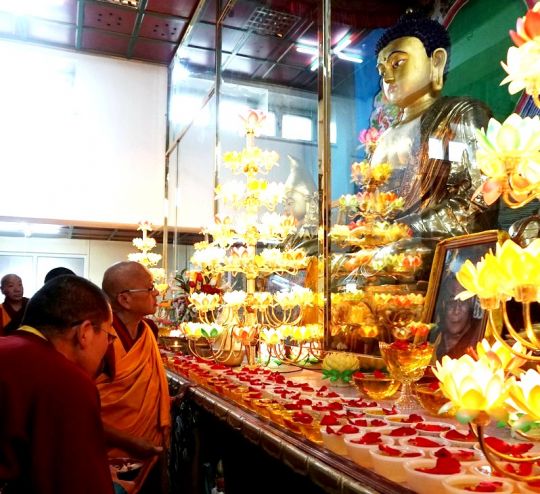
Lama Zopa Rinpoche makes offerings to the holy objects at Idgaa Choizinling Monastery,
Ulaanbaatar, Mongolia, May 2017. Photo by Ven. Lobsang Sherab.
Want to benefit others?
In the short video below, Lama Zopa Rinpoche talks about how to benefit others extensively, how to collect great merit, and how to reach full enlightenment. The video is an excerpt from his teachings at the 2016 Light of the Path retreat.
“Life is not long, life is short. We live with the wrong concept of permanence … That concept is cheating you,” says Rinpoche.
“How do we benefit others extensively?” he then asks. He answers, “Stop thinking and worrying about ‘When can I be happy?'” He adds that believing in the real “I” leads to anger, and understanding that it is merely labelled by mind puts a stop to reasons for anger and unhappiness.
Watch Lama Zopa Rinpoche on “How to Practice Skillfully and Collect Extensive Merits”:
https://youtu.be/ahVvZKNTQGg
Watch more video from the 2016 Light of the Path Retreat and find links to translations, MP3s, and the complete transcript:
https://fpmt.org/media/streaming/teachings-of-lama-zopa-rinpoche/light-of-the-path-teachings-2016/
Registration for the Light of the Path 2017 retreat closes this coming Friday, August 4. You can register for the retreat at https://www.blueridgeassembly.org/light-path-retreat/. Learn more about the retreat at: https://kadampa-center.org/light-path-retreat-2017/.
Light of the Path 2017 will be live webcast at: https://www.youtube.com/c/fpmtinc/live/. See more videos of teachings by Lama Zopa Rinpoche at Rinpoche Available Now: https://fpmt.org/rinpochenow/.
Lama Zopa Rinpoche is the spiritual director of the Foundation for the Preservation of Mahayana Tradition (FPMT), a Tibetan Buddhist organization dedicated to the transmission of the Mahayana Buddhist tradition and values worldwide through teaching, meditation, and community service.
26
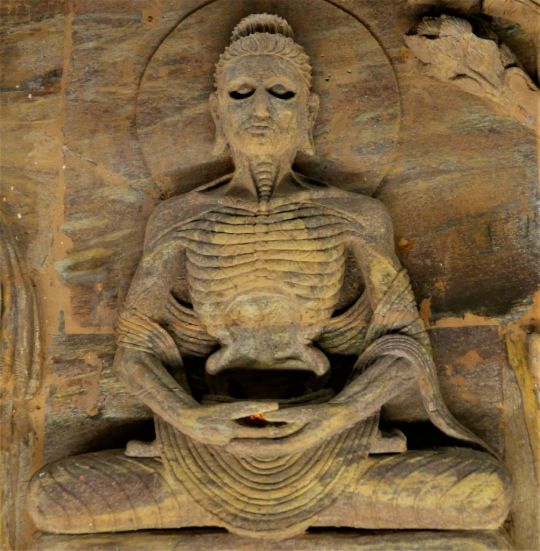
Statue portraying the Buddha during his years as an ascetic, taken during Lama Zopa Rinpoche’s visit, Root Institute, Bodhgaya, India, January 2017. Photo by Ven. Roger Kunsang.
Will renunciation bring us happiness or just more suffering?
Lama Zopa Rinpoche discussed this question in his book How to Practice Dharma: Teachings on the Eight Worldly Dharmas.
Lama Zopa Rinpoche advised that “any action done free from the three poisonous minds of greed, hatred, and ignorance is the cause of happiness … We don’t have to wait until our future lives to experience this happiness. As soon as we stop the dissatisfied mind, immediately—immediately—there is the result, happiness.”
“At first we might be nervous about letting go of desire,” he explained, “because it’s normal for us to equate desire with happiness. In fact, it is exactly the opposite. As soon as we let go of desire, we achieve inner peace, satisfaction, and happiness. We become independent. Before we were dictated to, controlled by desire, but now we have achieved real independence, real freedom.”
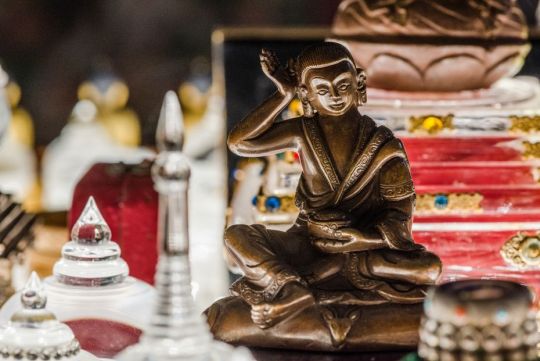
A statue of Milarepa at Kachoe Dechen Ling, Aptos, California, US, 2015. Photo by Chris Majors.
Citing the example of Milarepa, Rinpoche added, “Living without food, clothing, and reputation didn’t cause him any problems because of his Dharma practice. He achieved all the higher realizations and then enlightenment in that one lifetime all due to the power of his pure Dharma, renouncing suffering, renouncing this life. His mind was happier than that of the king.”
Rinpoche concluded by saying, “It is completely wrong to think that Dharma only brings happiness in future lifetimes but not in this one. Dharma brings peace and happiness to the mind the very moment we practice and live in the Dharma. We feel its effects immediately.”
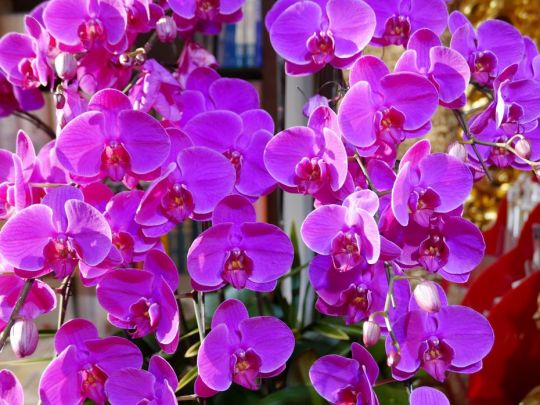
Flowers at Buddha Amitabha Pure Land, 2016. Photo by Ven. Roger Kunsang.
Lama Zopa Rinpoche is the spiritual director of the Foundation for the Preservation of Mahayana Tradition (FPMT), a Tibetan Buddhist organization dedicated to the transmission of the Mahayana Buddhist tradition and values worldwide through teaching, meditation, and community service.
- Tagged: lama zopa rinpoche, renunciation
- Home
- News/Media
- Study & Practice
- About FPMT Education Services
- Latest News
- Programs
- New to Buddhism?
- Buddhist Mind Science: Activating Your Potential
- Heart Advice for Death and Dying
- Discovering Buddhism
- Living in the Path
- Exploring Buddhism
- FPMT Basic Program
- FPMT Masters Program
- FPMT In-Depth Meditation Training
- Maitripa College
- Lotsawa Rinchen Zangpo Translator Program
- Universal Education for Compassion & Wisdom
- Online Learning Center
- Prayers & Practice Materials
- Overview of Prayers & Practices
- Full Catalogue of Prayers & Practice Materials
- Explore Popular Topics
- Benefiting Animals
- Chenrezig Resources
- Death & Dying Resources
- Lama Chopa (Guru Puja)
- Lama Zopa Rinpoche: Compendium of Precious Instructions
- Lama Zopa Rinpoche: Life Practice Advice
- Lama Zopa Rinpoche Practice Series
- Lamrim Resources
- Mantras
- Prayer Book Updates
- Purification Practices
- Sutras
- Thought Transformation (Lojong)
- Audio Materials
- Dharma Dates – Tibetan Calendar
- Translation Services
- Publishing Services
- Teachings and Advice
- Find Teachings and Advice
- Lama Zopa Rinpoche Advice Page
- Lama Zopa Rinpoche: Compendium of Precious Instructions
- Lama Zopa Rinpoche Video Teachings
- ༧སྐྱབས་རྗེ་བཟོད་པ་རིན་པོ་ཆེ་མཆོག་ནས་སྩལ་བའི་བཀའ་སློབ་བརྙན་འཕྲིན།
- Podcasts
- Lama Yeshe Wisdom Archive
- Buddhism FAQ
- Dharma for Young People
- Resources on Holy Objects
- Ways to Offer Support
- Centers
- Affiliates Area
- Teachers
- Projects
- Charitable Projects
- Make a Donation
- Applying for Grants
- News about Projects
- Other Projects within FPMT
- Support International Office
- Projects Photo Galleries
- Give Where Most Needed
- FPMT
- Shop
Translate*
*powered by Google TranslateTranslation of pages on fpmt.org is performed by Google Translate, a third party service which FPMT has no control over. The service provides automated computer translations that are only an approximation of the websites' original content. The translations should not be considered exact and only used as a rough guide.Death could come any minute so transform your life into Dharma.







